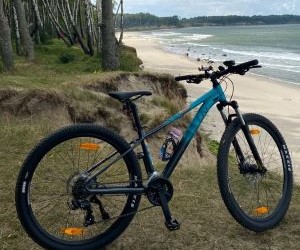Explore the best cycling and bike touring routes in Raleigh, from scenic greenways to wooded trails and smooth city rides—perfect for a vacation on two wheels.
HOW DO I SET UP MY FIRST BIKEPACKING TRIP?
Bikepacking combines the thrill of cycling with the freedom of camping, offering a unique way to explore nature at your own pace. For beginners, however, planning the first trip can feel overwhelming. From choosing the right gear to mapping a safe and exciting route, every detail matters. Without preparation, riders risk fatigue, logistical challenges, or even cutting the journey short. This article provides a comprehensive guide to planning your first bikepacking trip, covering essential gear, route selection, packing strategies, and practical tips to ensure a smooth adventure.

Choosing routes and planning
The foundation of a successful bikepacking trip is choosing the right route. Beginners should focus on manageable distances, accessible terrain, and areas with available resupply points. Ambitious routes can wait until you have more experience.
Factors for selecting your first route
Distance, terrain, and weather are the primary factors. A two- to three-day loop with mixed gravel and paved paths is ideal for first-timers. Opt for routes with campsites, towns, or services along the way for added security. Researching online bikepacking communities and platforms like Komoot or Ride with GPS helps identify beginner-friendly options.
Pre-trip planning essentials
Planning includes estimating daily mileage, identifying water sources, and checking weather forecasts. Riders should also familiarize themselves with local regulations regarding camping, especially in protected areas. A flexible plan ensures you can adjust based on fatigue or unexpected conditions.
Start with short, beginner-friendly routes
Include reliable resupply and camping options
Check weather and seasonal conditions
Use mapping apps designed for cycling and trails
Stay flexible with daily goals
By carefully selecting a route and planning logistics, first-time bikepackers reduce stress and focus on enjoying the adventure itself.
Essential gear and packing
Packing efficiently is key to a successful trip. Unlike traditional touring with panniers, bikepacking relies on frame bags, seat packs, and handlebar rolls that keep the bike balanced and nimble. Every item should serve a purpose.
Core gear for bikepacking
The essentials include a lightweight tent or bivy, sleeping bag, and sleeping pad. Cooking equipment depends on the trip length and resupply availability—some riders rely solely on cold meals, while others bring compact stoves. A multitool, repair kit, and spare tubes are non-negotiable for addressing mechanical issues.
Packing strategies
Weight distribution matters. Heavier items like tools and food should be stored low and centered in the frame bag. Lighter, bulky items like sleeping gear fit well in handlebar rolls or seat packs. Accessibility is also important—snacks, water, and navigation tools should be within easy reach.
Clothing and comfort
Layering is crucial for variable weather. Quick-dry cycling apparel, a rain jacket, and thermal layers provide versatility. Off-bike clothes add comfort at camp. Minimalism is key—pack only what you’ll use.
Lightweight shelter: tent, bivy, or hammock
Sleeping bag and pad suited to season
Frame, seat, and handlebar bags for balance
Tools, spares, and first aid kit
Layered clothing for variable weather
Packing smart means striking a balance between preparedness and simplicity. Overpacking is a common beginner mistake—less gear often equals more freedom on the ride.
Tips for a smooth first trip
Beyond gear and planning, success depends on mindset and small practical habits. First-time bikepackers should approach the trip with flexibility, patience, and a willingness to adapt to challenges.
Managing expectations
Not every mile will go smoothly. Weather, mechanicals, or fatigue may force adjustments. Viewing these challenges as part of the adventure helps maintain morale. A slower pace often reveals more of the landscape and makes the experience richer.
Food, water, and safety
Carrying sufficient water capacity and knowing where to refill is crucial. High-calorie, lightweight foods like nuts, tortillas, and dehydrated meals provide reliable fuel. A first aid kit, basic navigation tools, and a communication plan add safety layers, especially in remote areas.
Learning through experience
No first trip will be perfect, and that’s okay. Each adventure teaches lessons about packing, pacing, and personal comfort. Keeping notes for future trips accelerates learning and makes each subsequent ride smoother.
Adopt a flexible mindset and adjust plans
Plan food and hydration carefully
Prioritize safety with first aid and navigation tools
Treat obstacles as part of the journey
Keep notes to refine future trips
By approaching the first bikepacking trip as a learning experience, riders build confidence and skills that set the stage for bigger, more ambitious adventures. The goal is not perfection but enjoyment and growth.
YOU MAY ALSO BE INTERESTED






